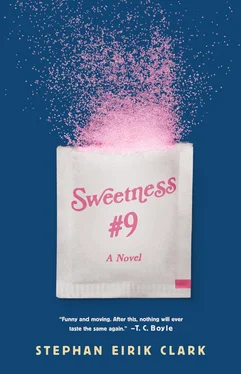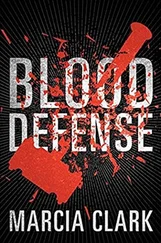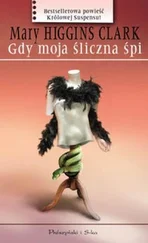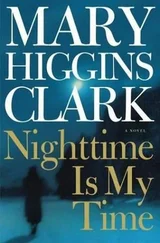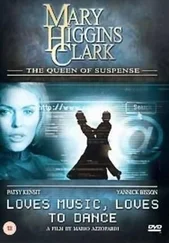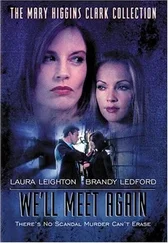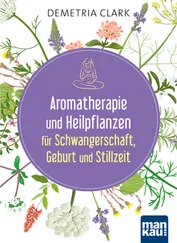And no matter how long I stood there, I couldn’t do it that night, I couldn’t convince myself anymore it was just the American Condition. I had let go of the left leg, and now, if only in the quiet of this darkness, I saw the whole prisoner before me, his body strapped down on the gurney, his arms splayed out at his sides, and the poison dribbling down through the IV, drip drip drip.
Part ThreeBLACK CHERRY MONDAY, August — September 1998
THIS WAS THE SUMMER the supermarket introduced its fleet of motorized carts. There were six in all, plugged into chargers at the front of the store. I never knew which was worse, walking behind one and reading the bumper sticker applied to the back of its padded black driver’s seat (RIDER WEIGHT NOT TO EXCEED 400 POUNDS) or feeling the presence of one too late and scrambling to get out of the way.
A few weeks after ordering the Albanian report, I walked aimlessly up and down the aisles of my local Acme, wanting only to avoid the relentless grilling I knew I could expect to face at home. (“What do you mean it’s still not here? You did order it, didn’t you?”) The supermarket had always been my refuge. I liked to study the corner displays to see who was paying for the most valuable real estate, or take in the boasts (Now with 25 percent more iron! New, improved flavor!) emblazoned on the bright packaging. Sometimes an old woman would even ask me to reach for a box on a high shelf, and I’d see I was going for a product flavored by my own hand.* How couldn’t I enjoy the fellowship of this place? The supermarket was our church, the last place where we all still congregated and mixed. You couldn’t take communion there, but if you timed your visit just right, you might find a smiling divorcée in a red apron, ready to offer you a sample of something savory on the end of a colored toothpick.
But then the Mart Carts were introduced and everything took on a new appearance, even something as simple and eternal as the eggs. Priscilla preferred brown. Brown eggs, brown rice, brown sugar, brown bread. The color white didn’t represent purity to her, as it had to the children of my generation. To her mind the color was evidence of a great deceit, so she insisted that we avoid it even when selecting our coffee filters.
I turned down the soft drink aisle and stood before the wall of two-liter bottles, studying the abundance of diet cola until I heard a faint electric whir coming toward me: a Mart Cart, this one driven by a morbidly obese woman who couldn’t have been more than forty years old. She was so large that her upper arms were held out at her sides, balanced on little ledges of fat, but it wasn’t this that left me flat-footed. It was her face, the doughy features of which were framed by limp, shoulder-length dirty-blonde hair. She wore such a fierce and pointed expression that I thought she must be driving her cart with the same fixed determination of a kamikaze pilot. I was almost too late. Just before she barreled into me, I threw myself into the display of soda, and it was then that I saw the first of the labels that so troubled me that evening. No preservatives or colorings, it read. One beneath it promised Absolutely nothing artificial, while even the half gallon of milk in my basket spoke to me with the language of a contrite lover: Our farmers would never use bovine growth hormones! When had we started selling an absence? An apology?
“Excuse me,” the woman said.
I turned to see her Mart Cart parked parallel to the cases of diet cola. She pointed to a twenty-pack of cans on the lowest shelf.
“Would you mind?”
I stepped toward her, hearing her say she couldn’t reach. But then I stopped short, as if refusing to be implicated in a crime.
“You know what’s good?” I said. “A little fizzy water with a splash of cranberry.” I’d heard this recommended on the radio just the other day, while listening to Mark and Bonnie talk to a pilot who’d suffered a seizure over Missoula after drinking a powdered pink lemonade in Cheyenne. Eighty-four people had almost lost their lives, and all for a few measly calories. “It’s got that fizziness I like so much,” I said, echoing Bonnie’s words, “and it even prevents urinary tract infections.”
The driver of the Mart Cart turned slowly in her seat, throwing first one leg down onto the floor and then the other. “You think because I carry a few extra pounds you can tell me what to eat?” She bent over and picked up the case by herself. “Asshole,” she said.
It wasn’t the year to be facing down a confession. Clinton was in office, and after his acknowledgment in mid-August that he’d had a “not appropriate” relationship with Monica Lewinsky, the pundits on TV and the columnists in the papers raised a hue and cry unlike any I’d heard since the early seventies. Clinton, Nixon — what did it matter who it was? It all came out in the end, and it was only bloodier if you dared delay it.
I first tried telling Betty about my past a couple of hours after I’d had a root canal. “There’s something I should say,” I told her, but I was drooling and drugged, my cheeks puffy, my mouth swollen. I might as well have been Khrushchev banging on a table with his shoe.
“Did you say you need to pay?”
Strangely, the urge to unburden myself only waned when I was around the one person who was most interested in hearing the truth: Priscilla. But then she made me feel so tense that I couldn’t help but be on the defensive around her.
“It’s been more than a month already, Dad. And still it’s not here? Did you really order it?” She wanted me to show her my credit card bill. “Trust but verify,” she said. “Isn’t that what you always tell me?”
Sarin didn’t make matters any easier. She had started spending more time at our house in order to teach my daughter how to make seitan and tempeh and live on little more than beans and grains. One evening while cooking, she tired of my routine deflections and told Priscilla they could always start their series with a think-piece on artificial colorings. Sarin had done some research, it seemed, and so she knew that Red Dye No. 3 wasn’t the only one to have been pulled from the market. No. 2 had also had its GRAS designation revoked.
“Russian studies in the early seventies linked it to increased rates of cancer in female rats,” she said.
“Why are you telling me this?” I asked.
“Do you have any comment?”
Priscilla had her notebook out.
“If you want to know the truth,” I told them, “I blame the Soviets. What better way to send jitters through the American marketplace than to question the safety of the dye that colors our lipsticks and hot dog casings? The Canadians are still using Red No. 2 today. You should write that down, Priscilla. Now, that’s all I’ll say on the matter. Communism will kill you quicker than a maraschino cherry ever will.”
At a certain stage in my life, work would have provided me all the shelter I needed. But in recent years the newspaper had started to publish articles about a rare and sometimes fatal form of fixed obstructive lung disease (“microwave popcorn lung,” they were calling it), and so now whenever I stepped into the lab and tinkered with my buttery artificial (every flavorist needs a pet project, something to occupy himself between contracts), it was as if that golden stick of butter I’d been chasing since my youth had been left out on a plate in the sun. I had no reason to fear the diacetyl (2,3-butanedione) that I mixed in my test tube; it only posed a threat to those workers at the factory who handled the chemical in bulk. But even so, even so.
I was sure I would feel better if only Ernest would start using verbs again. I knew he had it in him. The previous Thanksgiving he’d said, “Pass the gravy”—I was certain of it. And two Christmases ago, while we were sitting around the tree opening presents, he’d asked me, “Should I get another?” This was indisputable. I had videotaped evidence of it, evidence that I played for myself and Betty on more than one occasion that summer.
Читать дальше
